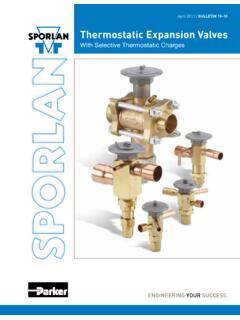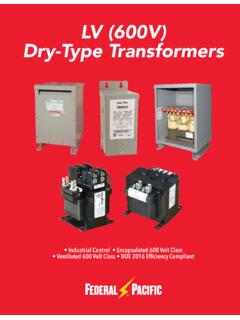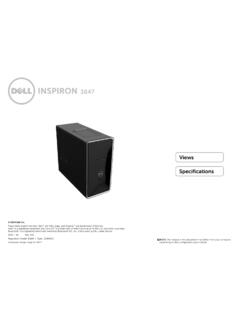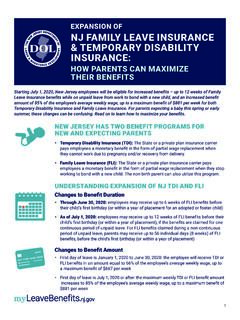Transcription of COVID-19 regulations waivers enable health system expansion
1 The Centers for Medicare & Medicaid Services (CMS). Fact Sheet for State and Local Governments CMS Programs & Payment for Care in Hospital Alternate Care Sites FINAL May 26, 2020. (Appendix added 1/19/21). Purpose In response to the COVID-19 public health emergency (PHE), state and local governments, hospitals, and others are developing alternate care sites to expand capacity and provide needed care to patients. The term alternate care site (ACS) is a broad term for any building or structure that is temporarily converted or newly erected for healthcare use. 1 The Federal Healthcare Resiliency Task Force issued a toolkit to help state and local governments develop an ACS. This document provides state and local governments developing alternate care sites with information on how to seek payments through CMS programs Medicare, Medicaid, and the Children's health Insurance Program (CHIP) for acute inpatient and outpatient care furnished at the site.
2 Key Takeaway The easiest path to obtaining payments through CMS programs for covered health care services furnished at the ACS is for an already-enrolled hospital or health system to treat the ACS as a temporary expansion of their existing brick-and-mortar' location. In these circumstances the local hospitals and health systems operate, staff, and bill for care furnished at the ACS. State and local governments 2 that want to establish (meaning to develop or build) a hospital ACS, and be paid by CMS for furnishing covered hospital inpatient and outpatient services to enrolled beneficiaries, have three options: 1. hand over operation and billing for care delivered in the ACS to an enrolled hospital or health system ;. 2. enroll the ACS as a new hospital in CMS programs; or 3. if options (1) and (2) are not available, CMS would not make facility payments, but qualified and enrolled physicians or other non-physician practitioners could bill for covered (professional 3 ).
3 Services that they furnish at the ACS. Because some state and local governments may not be as familiar with the process to enroll in CMS. programs as hospitals, they should contact their applicable CMS Regional Office (see Appendix D) to discuss this process. Additional information regarding new hospital enrollment and the flexibilities that existing hospitals and other providers have to expand capacity at ACSs during the PHE is below. 1 These sites are often called alternate care sites (ACSs), but may also be referred to as temporary expansion locations , temporary expansion sites , field hospitals , or by other names. This paper uses the term alternate care sites to align with the language used in the health Care Resiliency Task Force's toolkit. 2 The term state and local governments is used in this fact sheet to account for state, city, county, territorial and tribal governments and their respective agencies, including health departments.
4 3 When beneficiaries receive services at a traditional acute care hospital, Original Medicare will typically make two payments one for the hospital inpatient or outpatient facility services ( room and board or nursing) and one for professional services that physicians or non-physician practitioners furnish ( , evaluation and management). Under option 3, CMS would not make facility payments to the entity operating the ACS. However, even if the ACS does not enroll as a hospital, CMS may pay for professional services furnished to CMS beneficiaries at the ACS, as discussed in more detail in this fact sheet. In Medicaid/CHIP, specific benefit rules will also need to be followed. 1 5/26/2020. About CMS Programs Medicare is a federal health insurance program for people over 65, as well as certain young people with disabilities and those with End Stage Renal Disease (ESRD).
5 Typically, beneficiaries have a choice between Original Medicare and Medicare Advantage. Medicare Advantage plans are a type of Medicare health plan offered by a private company that contracts with CMS to provide Medicare benefits. Beneficiaries in Medicare Advantage plans have their services paid for by the private plan and not Original Medicare. When Medicare is discussed in this paper, it is referring to Original Medicare, and not Medicare Advantage, unless otherwise noted. Medicaid and CHIP provide health coverage to eligible low-income adults, children, pregnant women, elderly adults and people with disabilities. Medicaid and CHIP are funded jointly by states and the federal government, and the programs are administered by states, according to federal requirements. Medicaid and CHIP generally provide comprehensive benefits to people who are determined eligible by states; some benefits are required and some are optional.
6 Approaches to Hospital ACS Operations & CMS Programs Organizations have flexibility to develop ACSs in locations that best fit the needs of their community. Further, ACSs can provide a spectrum of health care services, from intensive care to primary care, depending on the capability of the site. Many organizations are using ACSs to create additional inpatient hospital capacity and are designing site operations to support care of COVID-19 - patients and non-COVID- 19 patients. There are three questions CMS 4 uses to determine whether it will pay for covered hospital facility inpatient or outpatient services furnished to enrolled beneficiaries at an ACS. 1. Is the ACS operator already enrolled in CMS programs as an acute care hospital or other provider type 5 that is able to furnish inpatient or outpatient care during the PHE?
7 2. Is the ACS operator contributing resources and responsible for the care being furnished to CMS. beneficiaries at the ACS? 3. Is the ACS operator following the billing requirements of the applicable Medicare, Medicaid, or CHIP hospital payment system ? Many acute care hospitals have established ACSs by converting existing non-clinical space for clinical use ( , cafeteria repurposed for care), as well as locations outside of the traditional hospital such as tents, retrofitted gymnasiums, convention centers, or other non-clinical locations. In these circumstances, the hospitals are already enrolled in CMS programs and are able to treat these locations as a temporary extension of their existing hospital footprint during the PHE under flexibility granted through so-called 1135 waivers (additional information about these waivers is in Appendix A).
8 CMS pays for inpatient and outpatient care furnished in these ACSs as if the care had been delivered in the hospital's traditional brick- and-mortar locations. Hospitals must follow all applicable CMS coding and billing rules during the PHE. 6. 4 Generally speaking, state Medicaid/CHIP programs would also use these questions to guide whether they would pay for covered inpatient or outpatient care at the ACS. However, state Medicaid/CHIP programs may have alternate approaches ACSs should contact their state Medicaid agency for more information. 5 Other facilities include Long-Term Care Hospitals, Critical Access Hospitals, Inpatient Rehabilitation Facilities, and others. Additional information about the flexibilities these facilities have to furnish acute care during the PHE is in Appendix C. 6 2 5/26/2020. State and local governments have also established ACSs, often with (non-CMS) federal support.
9 For example, state and local governments may seek reimbursement to develop ACSs from the Federal Emergency Management Agency's (FEMA) Public Assistance program (under Category B, emergency protective measures) which was authorized under the Robert T. Stafford Disaster Relief and Emergency Assistance Act of 1988 (Stafford Act). Other federal funding sources include the Department of health and Human Services' (HHS's) Hospital Preparedness Program and the Centers for Disease Control and Prevention's Crisis Response Cooperative Agreement. Some state and local governments have also requested HHS deploy portable medical facilities called Federal Medical Stations, and provide clinical staff through the National Disaster Medical system . 7 The Federal Healthcare Resiliency Task Force has published a guide to the funding opportunities state and local governments (as well as other organizations) can seek to establish and operate ACSs.
10 While some state and local governments operate acute care hospitals ( , certain county hospital and health systems), others may not be enrolled in CMS programs and, as a result, are not usually in a position to be paid immediately by Medicare or Medicaid/CHIP. However, state and local governments developing an ACS have options to seek payments through CMS programs for covered inpatient and outpatient services furnished to enrolled beneficiaries at the site. *Easiest Path* Partner with a hospital or health system : State and local governments can establish the site and then hand over operations of the ACS to an enrolled hospital (or other provider temporarily certified as a hospital 8 ), which can treat the ACS as a temporary extension of their brick-and-mortar location under 1135 waivers and bill CMS and state Medicaid/CHIP programs for covered hospital services furnished to enrolled beneficiaries.
















